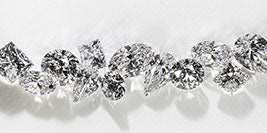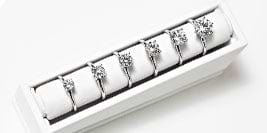Diamonds have shined as the ultimate fashion symbol of luxury for generations. However, the traditional diamond mining industry has faced scrutiny due to its environmental impact, labor practices, and ethical concerns.
In response to these challenges, a revolutionary alternative has emerged: cultured diamonds. Offering the same allure and beauty as mined diamonds, grown diamonds represent a sustainable and ethical choice for consumers. Let's delve deeper into the fascinating world of created diamonds and explore their significance in the jewelry industry.
What is a Cultured Diamond?
Cultured diamonds, also known as lab-grown or created diamonds, are produced through advanced technological processes that replicate the natural formation of diamonds within a controlled laboratory setting. These stones display exactly the same physical, chemical, and optical properties as mined diamonds, making them impossible to tell apart to the naked eye. They share the same chemical composition of 100% carbon, and both are judged on the same 4 C’s conditions, like color and clarity, carat weight, and cut.
A common misconception is that cultured diamonds are the same as moissanite, diamond hybrids, or cubic zirconia: this is simply not true. Lab diamonds are real diamonds. Consider this your cheat sheet on diamonds and diamond look-a-likes:
| Properties | Mohs Hardness | Diamond | |
| Grown Diamonds | 100% Carbon | 10 | Yes |
| Mined Diamonds | 100% Carbon | 10 | Yes |
| Moissanite | Silicon Carbide | 9.25 | No |
| Diamond Hybrid | Outer layer: 85% Carbon Inner layer: Non-precious crystal core | 8.8 | No |
| Cubic Zirconia | Zirconium Dioxide | 8.0-8.5 | No |
How do you create a cultured diamond?
Utilizing cutting-edge techniques such as chemical vapor deposition (CVD) and high-pressure high-temperature (HPHT) processes, scientists can mimic the conditions found deep within the Earth's crust where natural diamonds are formed.
Scientists produce CVD diamonds by depositing carbon molecules onto a carbon substrate, which forms a diamond crystal over time. CVD diamonds show exceptional purity and tend to be less expensive than HPHT diamonds.
Carbon growing into diamonds in the Chemical Vapor Deposition process.
HPHT diamonds, on the other hand, are formed when scientists subject carbon to extreme pressure and high temperatures — a process that replicates the conditions that create diamonds in nature. With a higher price point, HPHT diamonds are known for impressive color enhancement techniques, making them appealing to use in jewelry.
Both of these processes create diamonds with the same chemical properties as those found in the earth. Learn more about the differences between CVD and HPHT diamonds.
How do Created Diamonds compare to Natural Diamonds?
One of the most compelling advantages of cultured diamonds lies in their sustainability. Unlike traditional diamond mining, which involves extensive land excavation and can result in habitat destruction and soil erosion, lab diamonds are produced in controlled environments with minimal environmental impact. By reducing the demand for mined diamonds, grown diamonds contribute to the conservation of natural resources and help mitigate the ecological footprint associated with diamond extraction.
Moreover, the ethical considerations are paramount. The diamond mining industry has perpetuated troubling issues like forced labor, child exploitation, and conflict financing in regions where diamonds are sourced. Lab diamonds offer a transparent and ethical alternative, free from the ethical dilemmas that have afflicted the traditional diamond trade. Consumers can enjoy the beauty of diamonds with the assurance that their purchase upholds ethical standards and supports responsible practices.
How Valuable are Lab Grown Diamonds?
In addition to their aesthetic appeal, cultured diamonds are gaining recognition for their value proposition. While traditionally mined diamonds are subject to fluctuations in supply and demand, created diamonds offer a consistent and stable supply chain, resulting in more predictable pricing. This accessibility gives consumers an attractive, cost effective option for high-quality diamonds without the premium price tag often associated with mined diamonds.
Furthermore, lab-produced diamonds are making waves among environmentally conscious consumers and millennials who prioritize sustainability and ethical sourcing in their purchasing decisions - especially while shopping for an engagement diamond ring. As awareness of the environmental and social impact of consumer goods continues to grow, created diamonds are poised to become the preferred sustainable choice for discerning buyers who seek both luxury and responsibility in their jewelry acquisitions.
What types of Cultured Diamond Jewelry are for sale?
Beyond their sustainability and ethical credentials, grown diamonds also offer versatility and customization opportunities for jewelry designers and consumers alike. Scientists can produce diamonds in a wide array of colors, sizes, and shapes, allowing for creative expression and personalized design. Whether it's a classic solitaire engagement ring or a dazzling pair of earrings, grown diamonds offer endless possibilities for exquisite jewelry creations.
Cultured Diamond Engagement Rings
There’s nothing more classic and timeless than a simple solitaire ring. Ours has a classic style prong head holding a center stone of any shape atop a delicate rounded edge shank.
The 10 Stone is one of our best-selling engagement rings for a reason - it packs a lot of sparkle into a tight package with five round-cut lab-grown diamonds on either side of the center stone.
Lab-Created Diamond Bracelets
Make a statement with a Lab-Grown Diamond Tennis Bracelet, a gorgeous addition to any jewelry collection. Tennis bracelets stay in style year after year, making this a worthwhile style staple.
Bring a little edge to your outfit with a delicate chain of 14K Yellow Gold or White Gold and a single bezel-set diamond.
Cultured Diamond Earrings
Our lab-grown diamond studs can be made exactly as you like, with 7 different carat weights to choose from, in 2 metals, set in martini or basket styles.
Your diamonds will sparkle as they dangle from the lightweight lever-back earring mounting of our Basket Drop Earrings.
Lab-Grown Diamond Necklaces
The 3 Prong Martini Pendant is a beautiful delicate style, set with a Round Cut center stone on an 18in chain. Set it with different carat weights of lab diamond, or get colorful with a lab gem instead, like Blue Sapphire, Ruby, or Emerald.
Treat yourself with this Lab Grown Diamond Half Tennis Necklace, featuring 3.0ctw of Lab Grown Diamonds set in solid 14K White Gold.
Cultured Diamonds Increasing in Cultural Status
Lab-grown diamonds are revolutionizing the jewelry sector by providing a sustainable, ethical, and visually striking option compared to natural diamonds. With their eco-friendly production methods, ethical sourcing practices, and unparalleled beauty, lab diamonds are redefining the notion of luxury in the 21st century. As consumers increasingly prioritize sustainability and ethics in their purchasing decisions, cultured diamonds stand out as a shining example of innovation and responsible consumption in the world of fine jewelry.





























